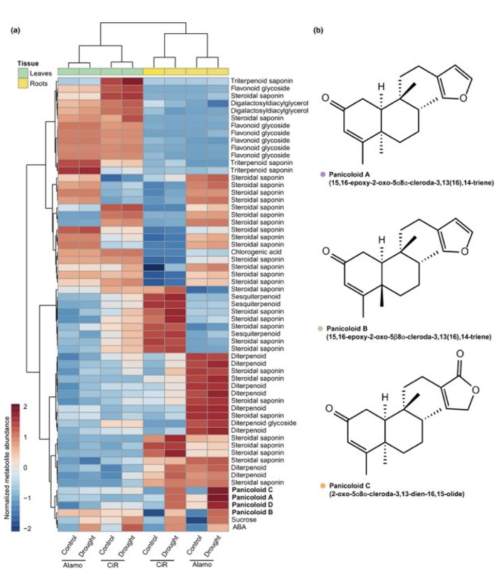
The C4 grass switchgrass (Panicum virgatum) is of agroeconomic value as a purpose-grown feedstock for lignocellulosic biofuel production. High net energy yield and a wide habitat range make switchgrass suitable for cultivation on marginal lands with reduced agricultural inputs, promising sustainable biofuel production. However, rising drought and other environmental pressures are projected to become major impediments for expanded switchgrass cultivation. A deeper knowledge of the molecular mechanisms that govern switchgrass environmental adaptation will offer critical resources for optimizing crop productivity. In related Poaceous grasses, including maize and rice, diverse terpene metabolites serve as primary defenses against biotic and abiotic stressors. In addition, plant-derived terpenes are used for producing biodiesel and jet fuels. The focal hypothesis of our switchgrass research is that dynamic networks of species-specific terpenoids serve as key components of switchgrass abiotic stress tolerance, knowledge of which can be harnessed through precision genome engineering to generate crops that are more resistant to stress and provide advanced biofuel production. Using our genome-wide gene functional analysis pipeline we have elucidated expansive terpene synthase (TPS) and cytochrome P450 monooxygenase (P450) gene families that form a modular metabolic network far larger than those identified in, for example, maize and rice. For instance, biochemical analysis of TPSs and P450s demonstrated the formation of a range of distinct specialized diterpenoids, several of which are, to our knowledge, specific to switchgrass. Combined metabolomics and transcriptomics studies of the lowland ecotype Alamo and the upland ecotype Cave-in-Rock illustrated significant stress-induced metabolic differences, including the drought-inducible accumulation of a group of newly identified diterpenoids, called panicoloids. Notably, panicoloids represent the primary metabolic changes in drought-stressed switchgrass roots. Additionally, panicoloids, alongside monoterpenoids such as camphor and borneol, are exuded from roots, supporting a role of switchgrass terpenoids in modulating root-microbiota interactions.

If you would like to read more:
- Wyatt G, Zerbe P, Tiedge K (2024) Characterization of switchgrass (Panicum virgatum L.) PvKSL1 as a levopimaradiene/abietadiene-type diterpene synthase. Plant Biol (Stuttg) doi: 10.1111/plb.13708. [Link]
- Tiedge K, Li X, Merrill AT, Davisson D, Chen Y, Yu P, Tantillo DJ, Last RL, Zerbe P (2022) Comparative transcriptomics and metabolomics reveal specialized metabolite drought stress responses in switchgrass (Panicum virgatum). New Phytol. 236:1393-1408. [Link]
- Tiedge K, Destremps J, Solano-Sanchez J, Arce-Rodriguez ML, Zerbe P (2022) Foxtail mosaic virus-induced gene silencing (VIGS) in switchgrass (Panicum virgatum L.). Plant Methods 18:71. [Link]
- Muchlinski A, Jia M, Tiedge K, Fell JS, Pelot KA, Chew L, Davisson D, Chen Y, Siegel J, Lovell JT, Zerbe P (2021) Cytochrome P450-catalyzed biosynthesis of furanoditerpenoids in the bioenergy crop switchgrass (Panicum virgatum L.). Plant J 108:1053-1068. [Link]
- Tiedge K, Muchlinski A, Zerbe P (2020) Genomics-enabled analysis of specialized metabolism in bioenergy crops: current progress and challenges. Synth Biol (Oxf) 5:ysaa005. [Link]
- Pelot KA, Chen R, Hagelthorn DM, Young CA, Addison JB, Muchlinski A, Tholl D, Zerbe P (2018) Functional Diversity of Diterpene Synthases in the Biofuel Crop Switchgrass. Plant Physiol. 178:54-71. [Link]
This research has been generously supported by:

